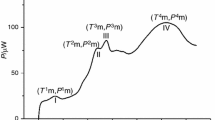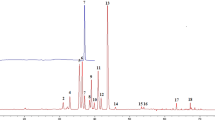Abstract
Botanical drug products have batch-to-batch quality variability due to botanical raw materials and the current manufacturing process. The rational evaluation and control of product quality consistency are essential to ensure the efficacy and safety. Chromatographic fingerprinting is an important and widely used tool to characterize the chemical composition of botanical drug products. Multivariate statistical analysis has showed its efficacy and applicability in the quality evaluation of many kinds of industrial products. In this paper, the combined use of multivariate statistical analysis and chromatographic fingerprinting is presented here to evaluate batch-to-batch quality consistency of botanical drug products. A typical botanical drug product in China, Shenmai injection, was selected as the example to demonstrate the feasibility of this approach. The high-performance liquid chromatographic fingerprint data of historical batches were collected from a traditional Chinese medicine manufacturing factory. Characteristic peaks were weighted by their variability among production batches. A principal component analysis model was established after outliers were modified or removed. Multivariate (Hotelling T 2 and DModX) control charts were finally successfully applied to evaluate the quality consistency. The results suggest useful applications for a combination of multivariate statistical analysis with chromatographic fingerprinting in batch-to-batch quality consistency evaluation for the manufacture of botanical drug products.








Similar content being viewed by others
References
Liang XM, Jin Y, Wang YP, Jin GW, Fu Q, Xiao YS. Qualitative and quantitative analysis in quality control of traditional Chinese medicines. J Chromatogr A. 2009;1216:2033–44.
Tistaert C, Djaegher B, Heyden YV. Chromatographic separation techniques and data handling methods for herbal fingerprints: a review. Anal Chim Acta. 2011;690:148–61.
World Health Organization. General guidelines for methodologies on research and evaluation of traditional medicine. Geneva: World Health Organization; 2000. www.paho.org/spanish/ad/ths/ev/PM-WHOTraditional-medicines-research-evaluation.pdf. Accessed 25 Feb 2013
Woodcock J. The concept of pharmaceutical quality. Am Pharm Rev. 2004;7:10–5.
Qu HB, Cheng YY, Wang YS. Some engineering problems on developing production industry of modern traditional Chinese medicine. Chin J Chin Mat Med. 2003;28:904–6.
Xiong HS, Gong XC, Qu HB. Monitoring batch-to-batch reproducibility of liquid–liquid extraction process using in-line near-infrared spectroscopy combined with multivariate analysis. J Pharm Biomed Anal. 2012;70:178–87.
Food and Drug Administration. Guidance for industry: botanical drug products. Rockville: Food and Drug Administration; 2004. http://www.fda.gov/downloads/Drugs/GuidanceComplianceRegulatoryInformation/Guidances/ucm070491.pdf. Accessed 19 Oct 2012
Xie PS, Chen S, Liang YZ, Wang X, Tian R, Upton R. Chromatographic fingerprint analysis—a rational approach for quality assessment of traditional Chinese herbal medicine. J Chromatogr A. 2006;1112:171–80.
Xie PS, Leung AY. Understanding the traditional aspect of Chinese medicine in order to achieve meaningful quality control of Chinese materia medica. J Chromatogr A. 2009;1216:1933–40.
Wangner H, Ulrich-Merzenich G. Synergy research: approaching a new generation of phytopharmaceuticals. Phytomedicine. 2009;16:97–110.
Zhou JL, Qi LW, Li P. Quality control of Chinese herbal medicines with chromatographic fingerprint. Chin J Chromatogr. 2008;26:153–9.
Jiang Y, David B, Tu PF, Barbin Y. Recent analytical approaches in quality control of traditional Chinese medicines—a review. Anal Chim Acta. 2010;657:9–18.
Liang YZ, Xie PS, Chau FT. Chromatographic fingerprinting and related chemometric techniques for quality control of traditional Chinese medicines. J Sep Sci. 2010;33:410–21.
Fan XH, Cheng YY, Ye ZL, Lin RC, Qian ZZ. Multiple chromatographic fingerprinting and its application to the quality control of herbal medicines. Anal Chim Acta. 2006;555:217–24.
World Health Organization. Guidelines for the assessment of herbal medicines. Geneva: World Health Organization; 1991. http://apps.who.int/iris/bitstream/10665/58865/1/WHO_TRM_91.4.pdf. Accessed 25 Feb 2013
Regional Office for the Western Pacific, World Health Organization. Research guidelines for evaluating the safety and efficacy of herbal medicines. Manila: Regional Office for the Western Pacific, World Health Organization; 1993.
World Health Organization. Quality control methods for medicinal plant materials. Geneva: World Health Organization; 1998. http://apps.who.int/iris/bitstream/10665/41986/1/9241545100.pdf. Accessed 25 Feb 2013
European Medicines Agency. Guideline on declaration of herbal substances and herbal preparations in herbal medicinal products/traditional herbal medicinal products. London: European Medicines Agency; 2010. http://www.ema.europa.eu/docs/en_GB/document_library/Scientific_guideline/2009/09/WC500003283.pdf. Accessed 19 Oct 2012
State Food and Drug Administration of China. Technical requirements for the development of fingerprints of TCM injections. Beijing: State Food and Drug Administration of China; 2000. http://www.sda.gov.cn/WS01/CL0237/15768.html. Accessed 19 Oct 2012
Chen C, Zhang H, Xiao W, Yong ZP, Bai N. High-performance liquid chromatographic fingerprint analysis for different origins of sea buckthorn berries. J Chromatogr A. 2007;1154:250–9.
Xie BG, Gong T, Tang MH, Mi DF, Zhang X, Liu J, et al. An approach based on HPLC-fingerprint and chemometrics to quality consistency evaluation of Liuwei Dihuang Pills produced by different manufacturers. J Pharm Biomed Anal. 2008;48:1261–6.
Xie Y, Jiang ZH, Zhou H, Cai X, Wong YF, Liu ZQ, et al. Combinative method using HPLC quantitative and qualitative analyses for quality consistency assessment of a herbal medicinal preparation. J Pharm Biomed Anal. 2007;43:204–12.
Cao Y, Wang L, Yu X, Ye J. Development of the chromatographic fingerprint of herbal preparations Shuang–Huang–Lian oral liquid. J Pharm Biomed Anal. 2006;41:845–56.
Gong F, Wang BT, Chau FT, Liang YZ. Data preprocessing for chromatographic fingerprint of herbal medicine with chemometric approaches. Anal Lett. 2005;38:2475–92.
Liang YZ, Xie PS, Chan K. Quality control of herbal medicines. J Chromatogr B. 2004;812:53–70.
Fang KT, Liang YZ, Yin XL, Chan K, Lu GH. Critical value determination on similarity of fingerprints. Chemom Intell Lab Sys. 2006;82:236–40.
Gan F, Ye RY. New approach on similarity analysis of chromatographic fingerprint of herbal medicine. J Chromatogr A. 2006;1104:100–5.
Alaerts G, Erps JV, Pieters S, Dumarey M, Nederkassel AMV, Goodarzi M, et al. Similarity analyses of chromatographic fingerprints as tools for identification and quality control of green tea. J Chromatogr B. 2012;910:61–70.
Yang LW, Wu DH, Tang X, Peng W, Wang XR, Ma W, et al. Fingerprint quality control of Tianjihuang by high-performance liquid chromatography–photodiode array detection. J Chromatogr A. 2005;1070:35–42.
Xu CJ, Liang YZ, Chau FT, Heyden YV. Pretreatments of chromatographic fingerprints for quality control of herbal medicines. J Chromatogr A. 2006;1134:253–9.
Gu RM, Tu HY, Sun H. Discussions on the chromatographic fingerprint similarity calculation methods of traditional Chinese medicine. Chin Trad Pat Med. 2009;31:988–90.
Nie L, Cao J, Luo GA, Wang YM. Comparison of different methods for evaluating the similarity of the fingerprints of traditional Chinese medicines. Chin Trad Pat Med. 2005;27:249–52.
Tian RT, Xie PS. Study on the standardization of similarity evaluation method of chromatographic fingerprints (part 1). Trad Chin Drug Res Clin Pharm. 2006;17:40–3.
Cheng YY, Chen MJ, Tong WD. An approach to comparative analysis of chromatographic fingerprints for the quality of botanical drugs. J Chem Inf Comput Sci. 2003;43:1068–76.
Xu SJ, Yang L, Tian RT, Wang ZT, Liu ZL, Xie PS, et al. Species differentiation and quality assessment of Radix Paeoniae Rubra (Chi-shao) by means of high-performance liquid chromatographic fingerprint. J Chromatogr A. 2009;1216:2163–8.
Tian RT, Xie PS, Liu HP. Evaluation of traditional Chinese herbal medicine: Chaihu (Bupleuri Radix) by both high-performance liquid chromatographic and high-performance thin-layer chromatographic fingerprint and chemometric analysis. J Chromatogr A. 2009;1216:2150–5.
Yang H, Zhao CX, Wang XM, Liang YZ, Zeng YX, Wu H, et al. Chromatographic fingerprint investigation for quality evaluation and control of Shengui hair-growth tincture. Planta Med. 2010;76:372–7.
Kourti T. Process analytical technology beyond real-time analyzers: the role of multivariate analysis. Crit Rev Anal Chem. 2006;36:257–78.
Miletic I, Quinn S, Dudzic M, Vaculik V, Champagne M. An industrial perspective on implementing on-line applications of multivariate statistics. J Process Control. 2004;14:821–36.
Chiang LH, Colegrove LF. Industrial implementation of on-line multivariate quality control. Chem Intell Lab Syst. 2007;88:143–53.
Kourti T. Application of latent variable methods to process control and multivariate statistical process control in industry. Int J Adapt Control Signal Process. 2005;19:213–46.
Zhang HJ, Wu YJ, Cheng YY. Analysis of ‘SHENMAI’ injection by HPLC/MS/MS. J Pharm Biomed Anal. 2003;31:175–83.
State Food and Drug Administration of China. State drug standards (no. WS3-B-3428-98-2010Z). Drug Standards Chin. 2011;12:158–60.
Chiang LH, Pell RJ, Seasholtz MB. Exploring process data with the use of robust outlier detection algorithms. J Process Control. 2003;13:437–49.
Kettaneh N, Berglund A, Wold S. PCA and PLS with very large data sets. Comput Stat Data An. 2005;48:69–85.
Wold S, Berglund A, Kettaneh N. New and old trends in chemometrics. How to deal with the increasing data volumes in R&D&P (research, development and production)—with examples from pharmaceutical research and process modeling. J Chemometrics. 2002;16:377–86.
Eriksson L, Johansson E, Kettaneh-Wold N, Trygg J, Wikström C, Wold S. Multi- and megavariate data analysis. Part I. Basic principles and applications. Multi- and megavariate data analysis. Part II. Advanced applications and method extensions. 2nd ed. Sweden: Umetrics Academy; 2006.
Acknowledgments
This work was financially supported by the China International Science and Technology Cooperation Project (no. 2010DFB33630).
Author information
Authors and Affiliations
Corresponding author
Additional information
Opinions expressed in this manuscript are those of the authors and do not necessarily reflect the views or policies of the FDA.
Rights and permissions
About this article
Cite this article
Xiong, H., Yu, L.X. & Qu, H. Batch-to-Batch Quality Consistency Evaluation of Botanical Drug Products Using Multivariate Statistical Analysis of the Chromatographic Fingerprint. AAPS PharmSciTech 14, 802–810 (2013). https://doi.org/10.1208/s12249-013-9966-9
Received:
Accepted:
Published:
Issue Date:
DOI: https://doi.org/10.1208/s12249-013-9966-9




